|
|
|
|
|
|
|
|
|
|
|
|
|
|
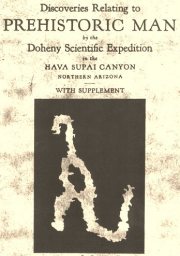 |
|
SUPPLEMENT
"Never utter these words: 'I do not know this, therefore it is false.'
One must study to know; know to understand: understand to judge."
APOTHEGM OF NARADA
TWO years have elapsed since this little pamphlet was published, and it has met with such a friendly reception that a new edition seems necessary. Many have sent kind words and encouraging suggestions, while others have hastened to tell of their own discoveries along similar lines, and generously offered to share them for the benefit of all.
Quite a voluminous correspondence has resulted, and word has been received from such far flung places as Australia and South Africa. Many have believed; a few have doubted; some have praised and some have sneered. In the pages following, I have compiled some of the most important contributions received during the past two years, with my own interpretation of their significance.
The amazing "Scopes Trial" has come and gone. An occasional gun is still fired in the form of some "bill" before a State Legislature to prohibit the teaching of evolution in the public schools. Perhaps it has been all to the good by stimulating public interest, but still the great problem of the "Origin of Man" remains unsolved. In my opinion it will not be solved as long as we approach the subject from the animal or material side only. We must take into consideration the evolution of man's soul as well as his animal body before we can expect to find the answer.
During this time it has been a struggle to keep from becoming involved in controversies over Evolution versus Creation. One ardent evolutionist has openly accused me of being a "fundamentalist," and insinuates that it is a crime to believe that a Supreme Being "created" man after his own image.
On the other hand, an equally ardent fundamentalist, Dr. George McCready Price, accuses the evolutionists of not playing fair. He says, "For many years the world has not had a square deal in connection with such discoveries as these. There has been a conspiracy of silence, by which all discoveries that did not accord with the popular theory of evolution have been systematically ignored and put on the top shelf, while every little item of evidence tending to support this theory has been proclaimed from the housetops, and broadcasted over the world by a syndicated press." It is our intention in this booklet to keep it as free as possible from all theories, from all dogma. There are two words that shine like beacons on the mountain tops; "Facts" and "Truth." What are the facts; what is the truth. In steering our course by these lights we feel sure we cannot go far wrong. The "undoctored incident that actually occurred" interests us more than anything else.
The whole history of Geology, of Paleontology, of Astronomy, in fact of all knowledge, is a continuing system of readjustments. New facts are discovered and our viewpoint changes. Madame Curie gave us more than radium; she opened our eyes to a new "Infinity." We had an idea of the infinitely "Great;" now we begin to have a realizing sense of the infinitely "Small." Michelson measured "Betelgeuse" and our ideas of "Bigness" had to be readjusted again.
We now go out under the Stars and the superb panorama of the Cosmos unfolds before our gaze, giving us a new sense of responsibility, a new feeling of being part of it all. We see there the operation of Great Laws, and we know there can be no great Law without a still greater Law Maker.
When we realize that the atoms composing our insignificant little bodies are in reality miniature solar systems, and that we are a replica of the Cosmos itself, we at once become clothed with a new sense of dignity and power. Whatever a man creates, something of his own Spirit enters into it; therefore, we have a right to assume that a Divine Creation is permeated with Divine Spirit. Now since man is built on the plan of the Cosmos, it therefore follows that some of that same Divine Spirit must be in us. For these reasons I am convinced of this Truth, "That God created man in his own image, in the image of God created he him."
Now when we go "Back-tracking Man through the Ages," seeking his origin, and link him only to the animal or lesser side, and ignore the greater or Spiritual side of his nature, we arouse a spirit of resentment among the people which finds expression in the Trial at Dayton, Tennessee, and in laws prohibiting the teaching of such a doctrine in the public schools. Nature is a marvelous Recorder, and if we approach the task in the proper spirit of reverence and humility we will eventually solve the mystery and arrive at the Truth.
IS THIS A HUMAN TOOTH?
| Dr. J. C. F. Siegfriedt of Bearcreek, Montana, sent this photograph
of what appears to be a human molar tooth. It was mined out
of vein No. 3 of the Eagle Coal Mine at Bearcreek, on November 5,
1926. These coal measures are in the Fort Union layers of the Eocene Period.
In his letter of January 12th, 1927, Dr. Siegfriedt, commenting on the attitude of suspicion and doubt which greeted his discovery, says:"I was simply bringing my discovery to the public notice and from the attitude that was hurled at me, one would think I was trying to hold up a bank. However I have the tooth and the most beautiful specimen at that. Since my discovery I find several gaps in the Geologic Time Table, which have not satisfactorily been explained." |
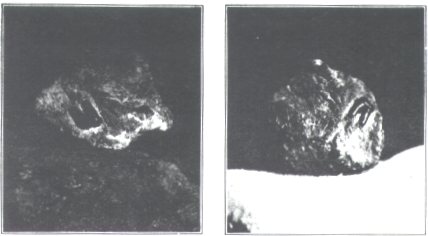
A Molar Tooth found in the Eocene Coal Measures at Bearcreek, Montana |
In the Literary Digest for December 18th, 1926, Dr. E. E. Free is quoted
from his Week's Science as follows:
"The geologic formation in which Dr. Siegfriedt found it belongs to what is called the Eocene Period. This formation was deposited perhaps as long as 75,000,000 years ago, certainly over 30,000,000 years ago. This is far more ancient than any remains of man previously discovered anywhere on earth. Accordingly, Dr. Siegfriedt's tooth, if really of human origin, is by far the oldest relic of man ever found. It pushes the beginnings of the human species much farther back into the past than geologists believe to be possible. Naturally, the Montana discovery has aroused the greatest interest among scientific men everywhere, their chief eagerness being to learn whether the tooth is necessarily human or whether it might be referred to some other animal, the existence of which in those long-ago times is more in accord with accepted geologic theories."The tooth is identified by Dr. Siegfriedt as a lower, left second molar, the middle of the three molars of the human jaw. It is about the size of a human tooth, being about one-third inch from the top of the crown to the tips of the roots. This is slightly smaller than the average of modern human teeth, but not so small as to make human origin impossible. The crown of the tooth is relatively low in comparison with the length of the roots, but this also is not inconceivable in a human tooth. Four cusps project from the crown; which is also an appearance found in some human molars, the fifth cusp which is theoretically present being sometimes so reduced in size as to be invisible. The roots are intact and are of the same general shape as those of human teeth. The entire tooth is partially carbonized and impregnated with iron sulfid, as a result of its long burial in the coal-beds where it was found."
THE TRIASSIC SHOE-SOLE
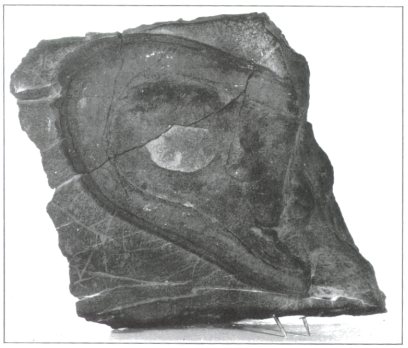
Fossilized Shoe-Sole, embedded in Triassic Mud, found by Albert E. Knapp in Pershing County, Nevada. |
THE photograph and description of this interesting fossil was sent
me by Mr. John T. Reid of Lovelock, Nevada. It was found by
Mr. Albert E. Knapp, near Fisher Canyon in Pershing County, Nevada. Mr.
Knapp writes me under date of January 15th, 1917, as follows: "In descending
the hill my attention was attracted by the fossil, which lay fossil side
uppermost amongst some loose rocks. I picked it up and put
it in my pocket for further examination, and on such examination came to
the conclusion that it is a layer from the heel of a shoe which had been
pulled from the balance of the heel by suction; the rock being in a plastic
state at the time. I found it in LIMESTONE OF THE TRIASSIC
PERIOD, a belt of which runs through that section of the hills."
Mr. Reid took the relic with him to New York, and had it analyzed by a competent geologist of the Rockefeller Foundation, who verified Mr. Knapp and pronounced it unquestionably TRIASSIC LIMESTONE. |
Micro-photographs were made which showed very clearly that it bore a minute resemblance to a well-made piece of leather, stitched by hand, and at one time worn by a human foot. The photographs showed the stitches very plainly; at one place it was double-stitched, and the twist of the thread could be clearly seen. The thread is smaller than any used by shoe-makers of today. Minute crystals of sulphide of mercury are to be noticed throughout the spaces of this fossil shoe-sole, these minerals having been deposited in the long ago by waters which carried them in solution.
In this fossil we have another link in the chain of evidence carrying man back to the "Age of Dinosaurs" in the Triassic Period. On page 10 we have a picture of a dinosaur, drawn by a human hand, under the direction of an intelligent human brain, presumably done in the Triassic Period when dinosaurs were still extant. Here we have more evidence of human workmanship in the form of a piece of fossilized leather, neatly stitched, and embedded in TRIASSIC MUD.
There are whole races of primitive men on Earth today, utterly incapable of etching that picture or sewing that moccasin. What becomes of the Darwinian Theory in the face of this evidence that there were intelligent men on Earth millions of years before APES are supposed to have evolved?
A SCULPTURED ROCK
THE photograph and description of this sculptured rock (BELOW) was sent by Dr. Dallas Loy of Waluga, Oregon. The relic belongs to the Oregon Historical Society at Portland. Curator George H. Himes tells about it as follows:"It was found in an old clearing about 15 miles East of Portland, near the Sandy River, a tributary of the Columbia River, which has its source on the western slope of Mount Hood, and is fed by glacial waters. According to my informant, who delivered it to me about 23 years ago, he said there were evidences in the vicinity of its having been an old Indian camp-ground. Logically there was no question about that in my mind, as the Sandy River was at one time a great salmon fishing stream in its season."
Dr. Loy describes the rock as being as heavy as basalt. It is about 3 feet long and 7 inches thick at the bottom. The other side is carved almost like the one shown, but hardly so well done.
Of course there is no way to estimate its age, or to know positively
what animal or creature the artist was trying to represent. My own impression
is that it is more like the armored dinosaur Stegosaurus than anything
I can think of. Originally it may have had both legs and tail.
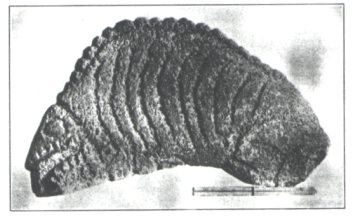
A Rock Carving found near the mouth of the Big Sandy River in Oregon |
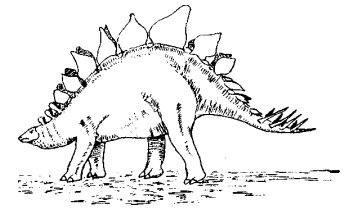
Restoration of Armored DINOSAUR STEGOSAURUS in National Museum, Washington, D. C. |
It was probably carved from a piece of volcanic tufa, which is more or less soft when in place, but which hardens on exposure to the air. The shape of the head, the prominent eye, and the protruding tongue strongly suggest the lizard or saurian type.
I assume the heavy scorings were intended to represent armor plates. If the prehistoric artist was making a Stegosaurus he evidently knew more about it than we do, for he shows it armored all over, while our restoration shows only the armor plates on the back, thus leaving the neck and sides open to attack. We may be reasonably certain that the labor involved in producing an object in stone, of such a size, would not be wasted on an insignificant creature like a small lizard or a fish.
A PREHISTORIC GAME-TRAIL
FROM the Grand Canyon in southern Utah comes another remarkable petroglyph. This was photographed and sent to me by Mr. George Kelly of Grand Junction, Colorado. The outline of the figure was so faint that he was obliged to chalk it in to secure a satisfactory photograph.
There is not the slightest question in my mind that this was intended to represent a rhinoceros. All the 'rhino' character is present. The menacing horn; the prehensile upper lip; the short tail; the heavy body and short legs, all suggest a 'rhino' about to charge. This is the first time it has ever been known that prehistoric man in America was contemporary with the rhinoceros.
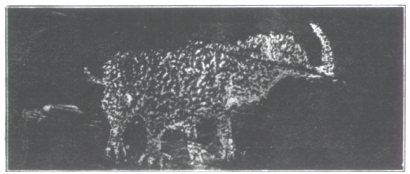
Petroglyph of a Rhinoceros
in the Sandstone Wall of the Grand
Canyon near Moab, Utah.
(Knife back of figure four inches long)
I have before me an outline of a wooly rhinoceros sketched by an artist-hunter on the limestone wall of the Cavern of Les Combarelles in France. The difference between the two is that the Cro-Magnon hunter shows the ears of his 'rhino' erect and pointed forward, while the American artist shows the ears turned over. I venture the prediction that there was that difference in the two animals.
Supplementing the pictures of ibex from the Supai Canyon, as shown on
page 14, I have received other ibex pictures from Nevada, Oregon, Utah
and Arizona. I am therefore forced to the conclusion that this must have
been a very common animal at one time inhabiting the whole Rocky Mountain
region. It was probably such a favorite game of the prehistoric hunters
that they finally exterminated it.
| From the "Tar Pits" of the Rancho La Brea in Hollywood, California,
we have taken skeletons of a number of animals now extinct in America.
Among others are the Elephant, the Camel, the Horse and the Lion, all of
which claim Africa as their habitat. (It will be recalled that there were
no horses in America when Columbus discovered the country.) Adding to this
list the ibex and the rhinoceros gives us 6 species that became extinct
in America and continued their existence in Africa. Did they originate
in America and migrate to Africa, or was it the other way around?
In either event there must have been a prehistoric game-trail leading from California to Africa across what is now the Atlantic Ocean. Further than that the presence of ibex in America would seem to indicate there must have been more or less continuous mountain ranges connecting the two continents. |
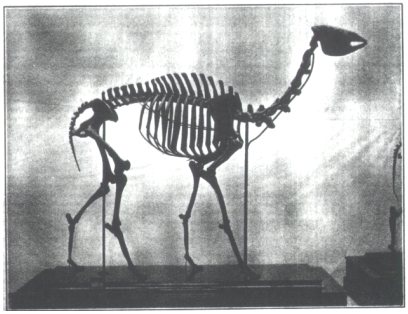
A Prehistoric Camel, from the La Brea Tar Pits in Hollywood, California. Los Angeles Museum |
I am well aware that there are many who think this migration took place
from Asia by way of Bering's Strait. This idea does not appeal to me for
the reason that practically all of these animals are desert dwellers. With
the exception of the ibex they thrive on desert plains and seek a hot climate.
The mountainous and forested terrain that stretches between California
and Alaska, plus the cold climate, would effectually bar their passage.
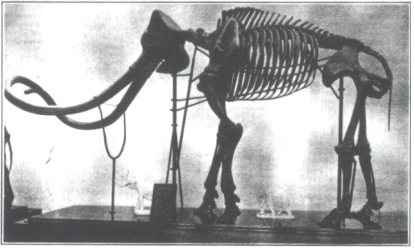
The Imperial Elephant of California. Skeleton found in the La Brea Tar Pits. Now on exhibition in the Los Angeles Museum. |
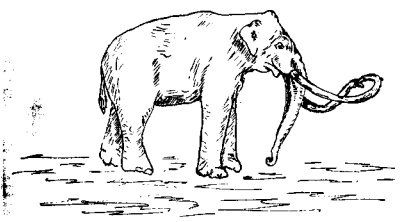
Restoration of the Imperial Elephant of California. This is the largest elephant ever found and stands 14 feet high at the shoulder. The remains of 28 elephants were found in one pit. |
I have before me a map purporting to show the World as it existed a
million years ago. According to this there was a continuous land area from
nearly all of what is now North America reaching across to Africa, Spain
and the British Isles. California, Nevada and Oregon are represented by
a large island, while most of British Columbia and Alaska were under the
sea. It is easy to use the word "BUNK" in connection with all this, but
after all is said and done the fact remains that the African animals are
here. They either furnished their own transportation on four feet, or prehistoric
people brought them in boats. I prefer to believe they followed a game-trait
across the desert.
NOTE.To those interested in the idea of an Atlantean Continent, I recommend the following works:The Lost Atlantis, by Ignatius Donnelly. A modern book by Lewis Spence, Atlantis in America, and a rare old book with six maps, entitled The Story of Atlantis by W. Scott-Elliot. The Lost Continent of Mu by Col. James Churchward, 1926.
|
|
|
|
|
|
|